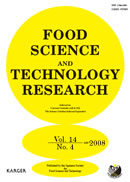14 巻, 4 号
選択された号の論文の14件中1~14を表示しています
- |<
- <
- 1
- >
- >|
Review
-
原稿種別: Review
2008 年 14 巻 4 号 p. 319
発行日: 2008年
公開日: 2009/01/31
PDF形式でダウンロード (539K)
Food Tehchnology and Engineering
Original papers
-
原稿種別: Original papers
専門分野: Food Technology and Engineering
2008 年 14 巻 4 号 p. 329
発行日: 2008年
公開日: 2009/01/31
PDF形式でダウンロード (1046K) -
原稿種別: Original papers
専門分野: Food Technology and Engineering
2008 年 14 巻 4 号 p. 337
発行日: 2008年
公開日: 2009/01/31
PDF形式でダウンロード (685K)
Note
-
原稿種別: Note
専門分野: Food Technology and Engineering
2008 年 14 巻 4 号 p. 345
発行日: 2008年
公開日: 2009/01/31
PDF形式でダウンロード (818K)
Food Science and Chemistry
Original papers
-
原稿種別: Original papers
専門分野: Food Science and Chemistry
2008 年 14 巻 4 号 p. 351
発行日: 2008年
公開日: 2009/01/31
PDF形式でダウンロード (572K) -
原稿種別: Original papers
専門分野: Food Science and Chemistry
2008 年 14 巻 4 号 p. 359
発行日: 2008年
公開日: 2009/01/31
PDF形式でダウンロード (629K) -
原稿種別: Original paper
専門分野: Food Science and Chemistry
2008 年 14 巻 4 号 p. 367
発行日: 2008年
公開日: 2009/01/31
PDF形式でダウンロード (1399K) -
原稿種別: Original papers
専門分野: Food Science and Chemistry
2008 年 14 巻 4 号 p. 377
発行日: 2008年
公開日: 2009/01/31
PDF形式でダウンロード (669K) -
原稿種別: Original papers
専門分野: Food Science and Chemistry
2008 年 14 巻 4 号 p. 383
発行日: 2008年
公開日: 2009/01/31
PDF形式でダウンロード (284K) -
原稿種別: Original papers
専門分野: Food Science and Chemistry
2008 年 14 巻 4 号 p. 389
発行日: 2008年
公開日: 2009/01/31
PDF形式でダウンロード (287K) -
原稿種別: Original papers
専門分野: Food Science and Chemistry
2008 年 14 巻 4 号 p. 395
発行日: 2008年
公開日: 2009/01/31
PDF形式でダウンロード (308K) -
原稿種別: Original paper
専門分野: Food Science and Chemistry
2008 年 14 巻 4 号 p. 403
発行日: 2008年
公開日: 2009/01/31
PDF形式でダウンロード (1025K)
Notes
-
原稿種別: Note
専門分野: Food Science and Chemistry
2008 年 14 巻 4 号 p. 409
発行日: 2008年
公開日: 2009/01/31
PDF形式でダウンロード (243K) -
原稿種別: Note
専門分野: Food Science and Chemistry
2008 年 14 巻 4 号 p. 415
発行日: 2008年
公開日: 2009/01/31
PDF形式でダウンロード (419K)
- |<
- <
- 1
- >
- >|
